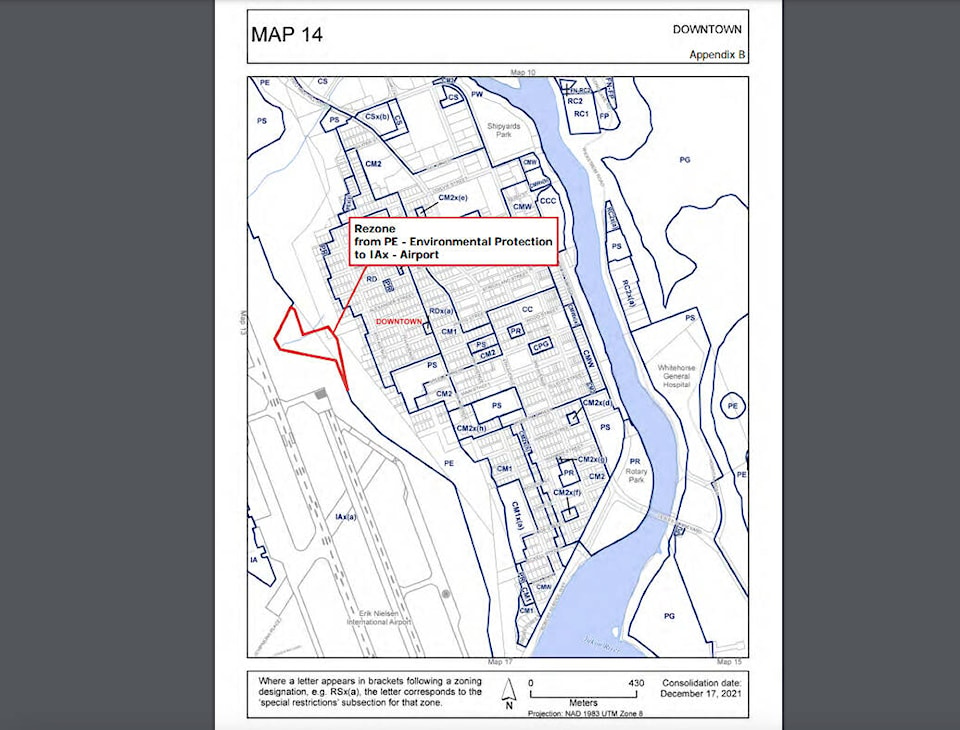A planned runway expansion at the Erik Nielsen International Airport could mean rezoning an environmentally protected area for airport use.
The proposal to designate land in the Puckett’s Gulch area as airport, rather than the current Environmental Protection zone, was brought forward at Whitehorse city council’s Aug. 1 meeting.
The plans would also see a portion of the airport trail, fence, road and a manhole moved to make way for the longer runway.
As Barrett Hatton, program manager with the territory’s department of Highways and Public Works, explained in a presentation to council, the airport is currently operating the runway with an exemption, but under Transport Canada regulations the larger 150 meter runway is anticipated to be needed for 737 traffic as passenger volumes return to pre-pandemic levels.
The 737s are flown by the likes of Air North, WestJet and Air Canada.
The proposal for the runway expansion location has taken into consideration the distance from the other runways at the airport and costs, Hatton said, pointing out the need to keep enough distance that work to one runway won’t impact another.
Senior city planner Mathieu Marois also explained the federal aviation safety standards in his report to council.
“Canadian Aviation Regulations require a runway end safety area (RESA) if the volume of passengers at an airport surpasses a certain threshold,” he said. “Once passenger volumes at the airport return to pre-pandemic traffic volumes, it is expected that runway 14L will require the addition of a new 150 metre RESA.”
The current airport boundary does not allow for the expansion, thus the territory is seeking the rezoning for city land next to the airport.
The changes will mean moving part of the airport trail, road, a manhole and the fence in the area to comply with regulations that state the runway strip must be cleared of all fixed objects.
Moving the manhole, which services a sewer line under the runway, would also mean relocating the sewer line around the runway to tie-in with Puckett’s Gulch.
Prior to coming forward for council consideration, the proposal was reviewed by the city’s development review committee (DRC), which cited several concerns with the plans.
Among them was the escarpment slides that happened from the end of April until June as the airport is located above the downtown escarpment.
“In light of the escarpment slides that had recently occurred in the city, the DRC felt it was necessary that geotechnical, surface drainage, escarpment stability, and construction plans be provided,” Marois said. “Additionally, it was noted that the proposal did not conform to the Downtown Escarpment Land Use Policy. YG Tourism and Culture also notified the city that the project area was in the process of a Heritage Review Impact Assessment (HRIA) and that work should not proceed until the results of the HRIA had been completed.”
It was determined by administration the issues raised by the DRC could be addressed through other process such as amendments to the escarpment policy, development agreement conditions and more.
As part of the subdivision, a development agreement would be needed with one of the conditions to include a detailed engineering design that would address impacts to the escarpment, slope stabalization and to the escarpment hazard zones at the bottom of the slope; slope stability; a storm management plan; sanitary sewer design; and a geotechnical review to address groundwater.
“The detailed engineering design will need to demonstrate that the proposed project will not extend the moderate geo-hazard area boundary further into the downtown area,” Marois said. “Additionally, the development agreement will address issues such as financial and safety responsibilities and snow storage management. YG will be required to communicate with the public about the project and minimize any disruptions to the Black Street stairs and active transportation corridor.”
Hatton said the stairs are not expected to be impacted by the plans.
Throughout the meeting, the importance of the trail to the community was emphasized by council members as well as Peter Long, a delegate who also addressed council on the proposed rezoning.
Long outlined the extensive use of the trail and the area’s history, arguing this has the potential to lead to the demise of the trail. He also highlighted the area as a wildlife corridor noting coyotes, lynx, deer and bears have been reported there.
Much of council’s discussion also focused on the trail with some arguing a public meeting should be hosted by the Yukon government to outline the plans.
While the city’s zoning bylaw allows council to call for such a meeting, that can not be done until after first reading.
Coun. Dan Boyd said the trail is important to the community, but also described the airport as “critical infrastructure.”
“We are seeing a lot of supply chain problems,” he said. “We’ve seen disruptions on the Alaska Highway for the last four or five years, a few of them. We’ve seen it where the weather or environmental conditions have restricted access into the North. Our flights in and out of Whitehorse are absolutely critical, extremely well-used through our business economy to just to the quality of life Yukoners enjoy.”
First reading of the rezoning bylaw is scheduled to come forward Aug. 8. If passed, a public hearing on the plans would be held Sept. 12 with a report then coming forward to council Oct. 3 ahead of the final two bylaw readings Oct. 11.
Should the rezoning be adopted, a lengthy process for the land to then be transferred to the territory would begin with an amendment to the downtown escarpment land use policy to reflect the zoning change. Disposition, subdivision and the formal land transfer would follow, including the development agreement.
Contact Stephanie Waddell at stephanie.waddell@yukon-news.com
